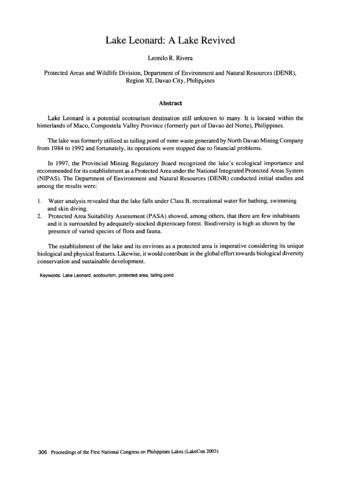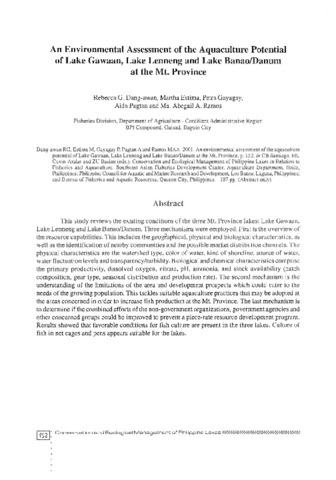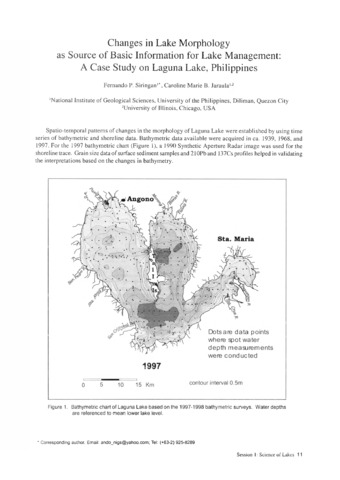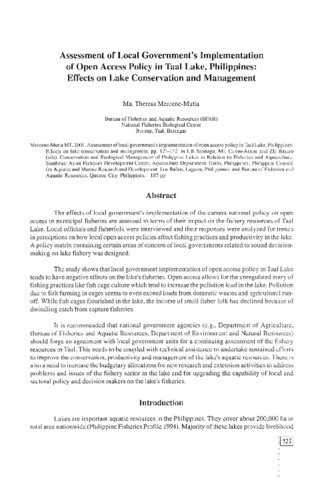Lake Leonard: A lake revived
| dc.contributor.author | Rivera, Leonilo R. | |
| dc.contributor.editor | Cuvin-Aralar, Maria Lourdes | |
| dc.contributor.editor | Punongbayan, Raymundo S. | |
| dc.contributor.editor | Santos-Borja, Adelina | |
| dc.contributor.editor | Castillo, Lourdes V. | |
| dc.contributor.editor | Manalili, Eduardo V. | |
| dc.contributor.editor | Mendoza, Marlynn M. | |
| dc.date.accessioned | 2021-07-28T01:10:42Z | |
| dc.date.available | 2021-07-28T01:10:42Z | |
| dc.date.issued | 2005 | |
| dc.identifier.citation | Rivera, L. R. (2005). Lake Leonard: A lake revived. In M. L. Cuvin-Aralar, R. S. Punongbayan, A. Santos-Borja, L. V. Castillo, E. V. Manalili, & M. M. Mendoza (Eds.), Proceedings of the First National Congress on Philippine Lakes (p. 306). Southeast Asian Regional Center for Graduate Study and Research in Agriculture (SEARCA). | en |
| dc.identifier.issn | 1656-8099 | |
| dc.identifier.uri | http://hdl.handle.net/10862/6155 | |
| dc.description | Abstract only. | en |
| dc.description.abstract | Lake Leonard is a potential ecotourism destination still unknown to many. It is located within the hinterlands of Maco, Compostela Valley Province (formerly part of Davao del Norte), Philippines. The lake was formerly utilized as tailing pond of mine waste generated by North Davao Mining Company from 1984 to 1992 and fortunately, its operations were stopped due to financial problems. In 1997, the Provincial Mining Regulatory Board recognized the lake s ecological importance and recommended for its establishment as a Protected Area under the National Integrated Protected Areas System (NIPAS). The Department of Environment and Natural Resources (DENR) conducted initial studies and among the results were: 1. Water analysis revealed that the lake falls under Class B, recreational water for bathing, swimming and skin diving. 2. Protected Area Suitability Assessment (PASA) showed, among others, that there are few inhabitants and it is surrounded by adequately-stocked dipterocarp forest. Biodiversity is high as shown by the presence of varied species of flora and fauna. The establishment of the lake and its environs as a protected area is imperative considering its unique biological and physical features. Likewise, it would contribute in the global effort towards biological diversity conservation and sustainable development. | en |
| dc.language.iso | en | en |
| dc.publisher | Southeast Asian Regional Center for Graduate Study and Research in Agriculture (SEARCA) | en |
| dc.subject | Lake Leonard | en |
| dc.subject | Tailing pond | en |
| dc.subject | Philippines | en |
| dc.title | Lake Leonard: A lake revived | en |
| dc.type | Conference paper | en |
| dc.citation.spage | 306 | en |
| dc.citation.conferenceTitle | Proceedings of the First National Congress on Philippine Lakes | en |
| dc.subject.asfa | ecotourism | en |
| dc.subject.asfa | protected areas | en |
| dc.subject.asfa | lakes | en |
Files in this item
This item appears in the following Collection(s)
-
LakeCon2003 [49]
Proceedings of the First National Congress on Philippine Lakes





